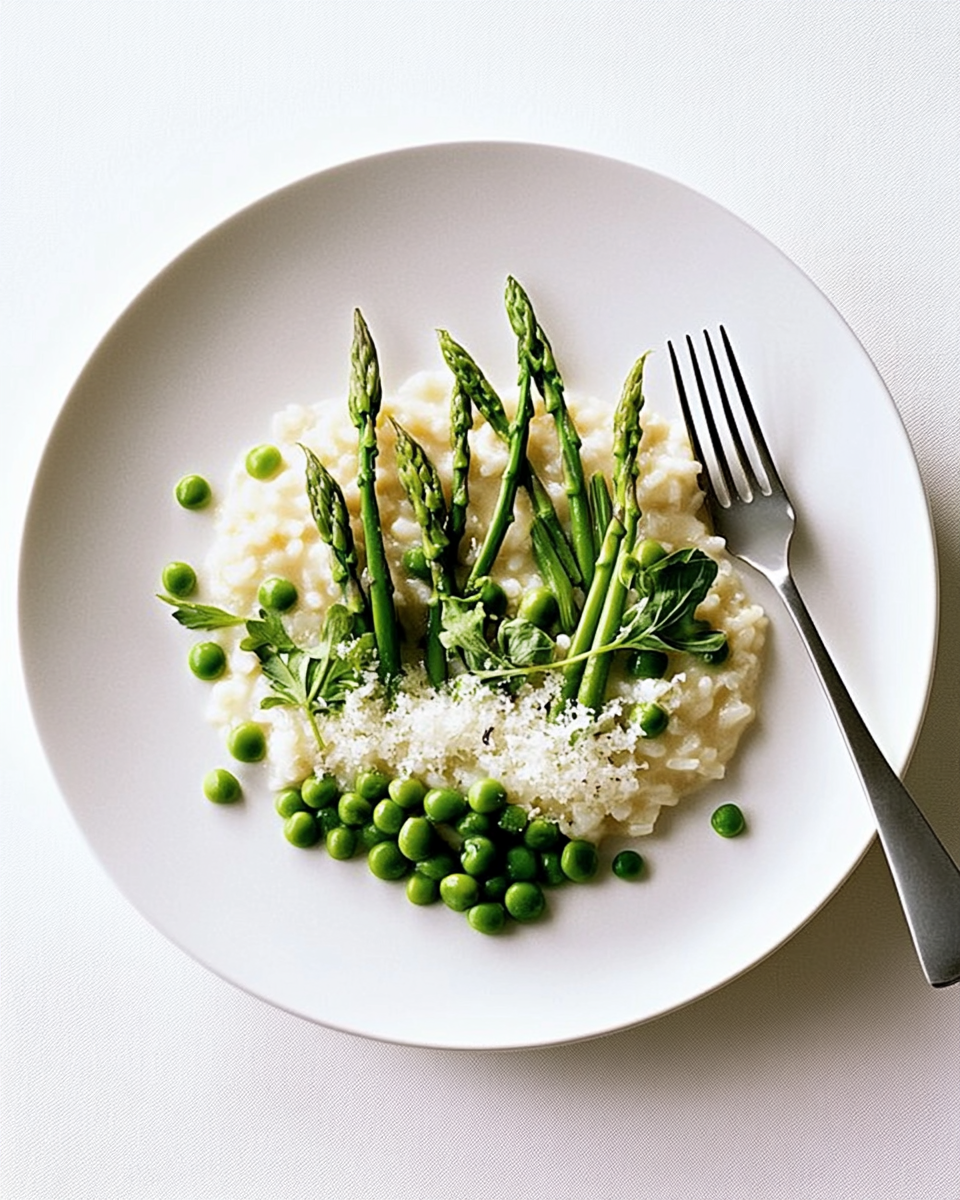A creamy, comforting risotto that combines tender asparagus and sweet peas for a fresh, flavorful dish. This recipe is perfect for a light dinner or a side dish to complement any meal. The risotto is simple to prepare and delivers a deliciously satisfying meal.
FULL RECIPE
Ingredients
- 1 cup Arborio rice
- 1 bunch asparagus, trimmed and cut into 1-inch pieces
- 1 cup frozen peas
- 1 small onion, finely chopped
- 2 garlic cloves, minced
- 4 cups vegetable broth
- 1/2 cup dry white wine
- 1/2 cup grated Parmesan cheese
- 2 tablespoons olive oil
- 2 tablespoons unsalted butter
- Salt and pepper, to taste
- Fresh parsley, chopped (optional)
Directions
- In a large saucepan, heat the vegetable broth over low heat and keep it warm.
- In a separate large pan, heat the olive oil over medium heat. Add the onion and garlic, cooking until softened, about 3 minutes.
- Add the Arborio rice to the pan and cook for 1-2 minutes, stirring to coat the rice in the oil and onions.
- Pour in the white wine and cook, stirring, until the wine is mostly absorbed.
- Add a ladle of warm vegetable broth to the rice, stirring constantly until the liquid is absorbed. Continue adding the broth, one ladle at a time, and stirring until the rice is tender and creamy, about 18-20 minutes.
- In the last 5 minutes of cooking, add the asparagus and peas to the risotto.
- Once the rice is cooked and the vegetables are tender, stir in the butter and Parmesan cheese. Season with salt and pepper to taste.
- Serve warm, garnished with fresh parsley if desired.
Nutritional Information
- Calories: 350-400 per serving
- Protein: 8g
- Carbohydrates: 55g
- Fiber: 4g
- Fat: 12g
- Saturated Fat: 5g
- Sodium: 800mg
History of Risotto
Risotto is a traditional Italian dish that has been enjoyed for centuries, with its roots dating back to Northern Italy. The dish is believed to have originated in Milan, where Arborio rice, a type of short-grain rice, was first cultivated. Over time, risotto became a staple in many regions of Italy, with various regions creating their own versions based on locally available ingredients. The word “risotto” comes from the Italian word “riso,” meaning rice. Its creamy texture, which results from slow cooking and constant stirring, is what makes risotto unique compared to other rice dishes.
What Makes Asparagus and Pea Risotto Special
Asparagus and pea risotto is a variation that brings fresh, seasonal vegetables into the dish, adding vibrant color and a burst of flavor. Asparagus is known for its delicate taste and crisp texture, while peas offer a sweetness that complements the richness of the risotto. Together, they create a perfect balance of flavors, making this version both nutritious and delicious. The dish is also an excellent way to showcase the beauty of spring produce.
The Health Benefits of Asparagus and Peas
Asparagus is a nutrient-dense vegetable packed with vitamins A, C, and K, as well as folate and fiber. It’s also a natural diuretic, helping to promote kidney health and flush toxins from the body. Peas are similarly rich in vitamins and minerals, offering a good source of plant-based protein, fiber, and antioxidants. Together, these vegetables help to support a healthy immune system, improve digestion, and reduce inflammation, making this risotto a wholesome choice for a well-balanced meal.
Choosing the Right Rice for Risotto
The key to making a creamy and delicious risotto is choosing the right type of rice. Arborio rice is the most commonly used rice for risotto due to its high starch content, which gives the dish its signature creamy texture. When cooked, Arborio rice releases starch, which combines with the broth to create a smooth, velvety consistency. Other types of rice, such as Carnaroli or Vialone Nano, can also be used, but Arborio remains the most popular choice for home cooks.
The Importance of Broth in Risotto
The broth you use in risotto plays a crucial role in determining the flavor of the dish. While vegetable broth is commonly used in asparagus and pea risotto for a lighter taste, chicken or beef broth can also be used for a richer, more robust flavor. It’s important to use a good-quality broth that is well-seasoned, as the rice will absorb much of the flavor during the cooking process. Always keep the broth warm while cooking, as adding cold broth to the rice can affect the texture and cooking time.
The Role of White Wine in Risotto
White wine is often added to risotto to deglaze the pan and infuse the dish with acidity and depth of flavor. The wine helps to balance the richness of the butter and Parmesan cheese, while also adding a subtle tanginess that complements the vegetables. It’s important to let the wine cook off completely before adding the broth, as this ensures the alcohol evaporates, leaving only the bright flavors behind.
The Best Way to Cook Risotto
Cooking risotto requires patience and attention, but the process is relatively simple. The key is to add the broth slowly, stirring constantly, which allows the rice to release its starch and create a creamy texture. It’s important not to rush this step, as adding too much broth at once can result in a soupy consistency. Stirring frequently helps to prevent the rice from sticking to the pan and ensures even cooking. The end result should be a dish with a creamy, yet slightly al dente texture.
Adjusting the Texture of Risotto
One of the hallmarks of a good risotto is its creamy texture. If the risotto feels too thick, you can add a bit more warm broth to loosen it up. On the other hand, if it’s too runny, continue cooking for a few more minutes to allow the excess liquid to evaporate. The risotto should be soft but still have a slight bite to the rice. The key is to taste the risotto throughout the cooking process to ensure it reaches the desired consistency.
The Role of Parmesan Cheese in Risotto
Parmesan cheese is a classic addition to risotto that enhances its creamy texture and adds a savory depth of flavor. The cheese also helps to bind the dish together, giving it a rich, velvety finish. When making asparagus and pea risotto, freshly grated Parmesan is recommended for the best flavor. Avoid using pre-grated cheese, as it may lack the intense flavor of freshly grated Parmesan. If you prefer a stronger cheese, you can also add Pecorino Romano for a sharper, saltier taste.
Adding Butter for Creaminess
Butter is another essential ingredient in risotto that contributes to its creamy, luxurious texture. Once the risotto has finished cooking, adding a dollop of butter helps to enrich the dish and make it even more indulgent. The butter also enhances the overall flavor, balancing out the richness of the Parmesan and the freshness of the vegetables. It’s important to use unsalted butter to control the amount of salt in the dish.
How to Season Risotto
Seasoning is crucial in risotto, as the rice and broth can be quite neutral in flavor. Salt and pepper should be added to taste, but it’s important to be cautious with the amount of salt, especially if using a store-bought broth that may already contain sodium. Fresh herbs, such as parsley or basil, can be added at the end for a burst of color and freshness. Additionally, a squeeze of lemon juice can help to brighten the flavors and add a zesty finish to the dish.
Risotto Variations
While asparagus and pea risotto is a delicious combination, there are endless variations to explore. For a more indulgent version, you can add seafood, such as shrimp or scallops, or even chicken for extra protein. For a heartier meal, try adding mushrooms, such as porcini or cremini, for an earthy flavor. Experimenting with different vegetables and seasonings allows you to create a personalized version of risotto that suits your taste.
Perfect Pairings for Asparagus and Pea Risotto
Asparagus and pea risotto pairs wonderfully with a variety of dishes. For a light, vegetarian meal, serve it alongside a fresh salad or grilled vegetables. If you’re looking for a protein to accompany the risotto, roasted chicken or grilled fish are excellent choices. A crisp, white wine such as Sauvignon Blanc or Pinot Grigio is the ideal wine to serve with this dish, as its acidity complements the creamy risotto and fresh vegetables.
Risotto as a Side Dish
Although risotto is often served as a main course, it can also be a fantastic side dish to accompany a variety of meals. Its creamy texture and mild flavor make it a perfect complement to roasted meats, grilled fish, or even a vegetable-based main course. When served as a side, risotto adds richness and comfort to the meal, while still allowing the main dish to shine.
The Importance of Fresh Ingredients
For the best results, it’s important to use fresh, high-quality ingredients when making asparagus and pea risotto. Fresh asparagus and peas not only contribute to the flavor and texture of the dish, but they also add vibrant color. Using fresh, seasonal vegetables ensures that the dish is as flavorful and nutritious as possible. If fresh vegetables are not available, frozen asparagus and peas can be used as a substitute.
Risotto for Special Occasions
Risotto is a versatile dish that can be adapted for various occasions. Its creamy texture and elegant presentation make it a great choice for dinner parties, holidays, or romantic meals. By adding different ingredients or adjusting the flavors, you can create a risotto that suits the occasion. Whether you’re serving it as a main course or as a side, risotto is sure to impress your guests.
Advertisement
The Time Commitment of Making Risotto
One of the challenges of making risotto is the time commitment required to prepare it. Unlike many other dishes that can be prepared quickly, risotto requires constant attention and stirring. However, the process is straightforward, and the end result is well worth the effort. Setting aside about 30-40 minutes to cook the risotto ensures that it will turn out perfectly creamy and flavorful.
Risotto Leftovers
Risotto is best enjoyed fresh, but leftovers can be stored in an airtight container in the refrigerator for up to 2-3 days. To reheat, simply warm the risotto in a saucepan over low heat, adding a bit of broth or water to loosen it up. While the texture may not be as creamy as when it was first made, it will still be delicious. Risotto can also be transformed into a new dish by turning it into risotto cakes or adding it to soups or stews.
Conclusion
Asparagus and pea risotto is a delightful dish that combines the creamy richness of risotto with the fresh flavors of seasonal vegetables. By using high-quality ingredients and taking the time to carefully cook the rice, you can create a dish that is both comforting and sophisticated. Whether served as a main course or a side, this risotto is a great way to enjoy the vibrant tastes of spring. With its versatility and ease of preparation, it’s a dish that can be adapted for any occasion, from a casual family dinner to a special celebration.






